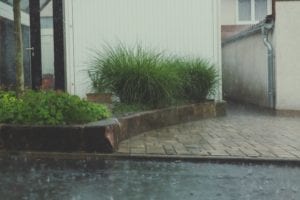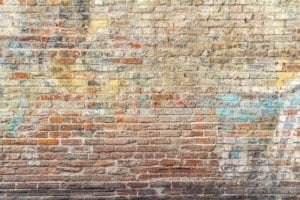When moisture penetrates your exterior walls, it does a lot of damage. It is therefore a good idea to waterproof your walls to ensure that the moisture does not penetrate further into your home. Read this article to find out why it is important to waterproof your walls and how and with what you do it.
Wall waterproofing: the cost
Waterproofing your wall naturally comes at a cost. However, it is important to do this as moisture in exterior walls very quickly seeps through to interior walls. There are several ways to make your wall waterproof. For instance, impregnating your wall, covering it with waterproof cladding and applying damp-proof paint. The costs involved depend on several factors; what material is the wall made of, for instance? Do you have a brick wall or a concrete wall and how many square metres are involved? In the table below you will find the average costs for damp-proofing walls.
| Method | Average costs |
|---|---|
| Impregnating | £10-15 per M² |
| Waterproof cladding | From £35 per M² |
| Moistureproof paint | £30-£45 per M² |
Find the best specialist for your project and get free quotes.
Start

Causes and consequences of damp walls
Dampness problems are very annoying, because it brings with it unpleasant consequences. For instance, walls with moisture damage are very likely to crack when it freezes. These cracks make it even easier for moisture to penetrate further inside. Moisture in the wall then turns into penetrating moisture and starts to express itself inside as well. Moisture in the house quickly causes health problems such as flaring allergies and it worsens asthma and rheumatism, which is mainly because dampness often causes mould in the house.
In addition to noticeable effects on your health, it is of course also not a pretty sight, brown stains on your walls. This also causes you to have to paint the inside and outside wall. Therefore, it is very important to waterproof your wall. Moisture damage (penetrating damp) is often primarily due to poor jointing in a stone wall or ageing stone strips. Wood should also be waterproofed, as water can still enter through small gaps or cracks. Rising damp has different causes and therefore requires different control techniques.
Methods for waterproofing a wall
There are different methods for waterproofing your walls. All three methods can be applied to almost all types of walls. Read the headings below for more information.
Impregnating
Wall impregnation involves the moisture specialist spraying impregnating agent into the external wall at high speed, making the wall water-repellent and weatherproof. For this reason, the technique is also called hydrophobing. The product forms a transparent layer on the façade, making the wall resistant to almost all weather conditions. Impregnating your facade is the fastest way to combat moisture.
Waterproof cladding
When you choose waterproof cladding to make your wall watertight, you also give your house a new look and it helps insulate your house. This also makes it a lot pricier than impregnating your exterior wall. There are several options for plastering your outside wall, such as stone strips, kalei or crepi. A moisture specialist will help you choose what suits your house best. This method is certainly advisable if you have old stone walls, as there is a good chance that the damp problem will return if you do not fill the cracks with new material.
Damp-proof paint
If you suffer from rising damp, painting your exterior wall with damp-proof paint is a good option. Like cladding, damp-proof paint gives your house a new look. Damp-proof paint comes in many different colours, often bitumen paint. However, you should first have your facade cleaned to get a good result, which usually costs £5 to £15 per m². You will need about two coats of the damp-proof paint and it is important that this is done very carefully for the best result. If you want to outsource this, you will get wall painting prices on top of that. All walls are suitable for this option, from brick walls to plastered walls, although the wall may be too damp; the damp specialist measures this with a moisture meter.
Do you need a permit?
Do you want to waterproof your wall by means of wall cladding or damp-proof paint? Then check with your local council first to see if you need permits for this. Painting an exterior wall is permit-free in most cases, but it varies per municipality. Resurfacing your facade involves permits in more cases.
The Environmental Law Decree states that no permit is required when doing odd jobs on a structure as long as:
- The load-bearing structure does not change
- The building volume/built-up area is not increased
- The fire compartmentation does not change
In principle, if you meet these requirements and your house is not on the World Heritage List, you are free to clad your exterior walls. However, to make sure you won’t have any problems with the cladding, it is always good to check that there really won’t be any problems. This is because your local council’s building standards committee is free to act if you exceed their building standards policy, and this varies from one municipality to another.

Saving tips for damp proofing
Having your wall waterproofed is a pricey project. Therefore, you probably want to save costs wherever possible. Read some savings tips below.
Pay attention to what is included in the price
Specialists often charge call-out fees and require additional materials. For example, a painter often needs scaffolding, which is not always included in the price. Also check whether VAT is already included in the price or whether it is added. Discuss the total costs well before you go with a company, so you will not be faced with unexpected costs.
Combine projects
Are there several places in your house where you suffer from moisture damage and can it be solved with the same method? Then make sure you bundle these jobs in your quote request. Then the specialist will not have to come twice and you will save a lot of money. Also discuss your plans with the neighbours; for large jobs it is often possible to agree on a volume discount.
Help along
Make sure you have made as many preparations as possible before the moisture specialist comes. Make sure the moisture spots are easily accessible and cover up any (garden) furniture. Ask in advance if there are any issues where you can lend a hand. That way, you really only pay for his or her expertise and do not waste time on things you could easily have done yourself.
Winter painter
If you have decided to waterproof the wall using damp-proof paint, consider having this done in winter. In winter, painters often have fewer jobs which means they give discounts faster. This can save 10 to 20 per cent on the total cost.
Find the best specialist for your project and get free quotes.
Start